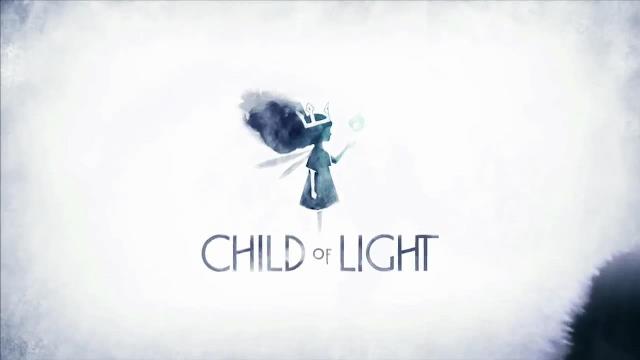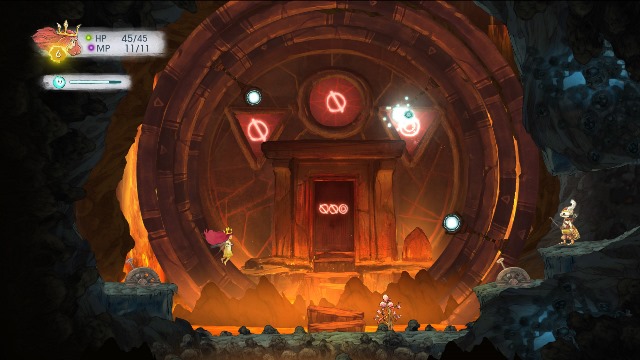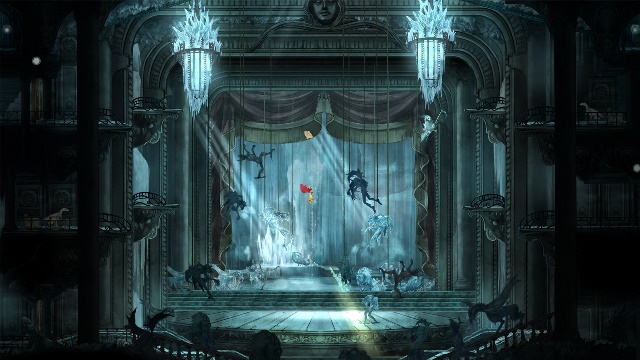Child of Light review (Xbox One)
Child of Light was developed by Ubisoft Montreal and published by Ubisoft. It was released April 30, 2014, on the Xbox One and Xbox 360 for $14.99. An Xbox One copy was provided for review purposes.
Child of Light is a game that isn’t afraid to take what it likes. Ubisoft Montreal’s pastiche borrows liberally from the JRPGs of yesteryear in paying homage to them. Its roughly 12-hour adventure is filled with bits from its source material: Final Fantasy VII‘s sword gigantism, Final Fantasy X‘s in-battle character swapping and a sidekick that acts like a more palatable version of Ocarina of Time‘s Navi and looks like a Dragon Quest Slime, to name a few.
The story also feels like it was cut from the same cloth of many seminal RPGs. It revolves around a group led by the titular Child of Light (Aurora) on a quest to save the fairy tale world of Lemuria from the Black Queen, who has pilfered the land’s sun, moon and stars and appropriated its throne for herself. Child of Light‘s pitting of good-natured youngsters against an evil covering the world in darkness is nothing new, and its world, while beautiful, can be less than exciting to traverse. You might not then expect a game aspiring to be an indie love letter to the JRPG composed by the blockbuster shooter production crew at Ubisoft Montreal to keep you happily adventuring along. Thanks to a sublimely addictive combat system, pretty artwork and a delightful cast of characters, however, you’ll continue to gravitate towards this quest until you reach its conclusion.
Here’s what we liked:
Tug of war — The “Defend” action in RPGs is usually a dull and bothersome selection, a necessary evil when your back is against the wall. Ubisoft Montreal has found a way to make it interesting, though. Child of Light‘s combat is governed by the active time battle gauge (referred to here as the Timeline) seen in so many role-playing games over the years. The twist here is that additional time is required between selecting an action and performing it. It’s during this time that players will often want to forgo attacking in favor of turtling up to protect themselves and expediting their movement along the Timeline during the next go around. This is because all actions save defending can be interrupted by successful attacks, pushing a character’s position on the Timeline back without allowing them to perform their selected action. Good planning and the occasional spot of luck allow you to impede foes, minimizing their number of successful actions and maximizing your own. This results in battles playing out like a tug of war over Timeline positioning. Losing your position before casting the powerful spell you had lined up stings, but only enough to convince you to play smarter: you’ll plan your next strike to be executed during the small window of opportunity that allows you to gain Timeline control and smile when you do.
It all looks so pretty — Being forced to occasionally wait before taking action is alleviated by the game’s lovely character designs and pleasing battle animations. The most satisfying examples come in the form of spells that have been leveled to the maximum. Watching Aurora encircling herself in stars before blasting monsters with light or Finn the sorcerer producing an electrical storm to zap adversaries are payoffs that are worth the wait. Getting hit can even entertain to a degree, as Aurora’s protective crown is knocked from her head of persistently flowing red hair each time she takes damage. Outside of battle, the hand-drawn world of Lemuria is a charming one that’s populated by an attractive bestiary and cast of playable characters.
A strong cast — It’s more than just beautiful artwork that makes the company Aurora keeps interesting. Nearly every character who joins the adventure is immediately likable. Ubisoft Montreal has surrounded its young female lead with individuals whom you’ll want to help, which is good because since this is an RPG basically everyone needs assistance with something. Amazingly, even though everybody converses exclusively in rhyming dialogue, chitchats between party members are stimulating enough to make you sympathetic to each one’s plight. When the warrior Óengus asks you to deviate from the main path and travel to the depths of a labyrinth to free his imprisoned clansmen you won’t think about it; you’ll just do it. Though the struggle to free the world from darkness is old hat for JRPGs, Child of Light‘s characters personalize it in such a way that fully invests you in their personal chapters.
Here’s what we didn’t like:
A pair does not a party make — Yes, Child of Light‘s battle system is great, but it could have been even better. You’ll spend the entire game wondering when Ubisoft will finally open things up some by adding more active characters and enemies to battles. Spoiler: it never does. In battle, your party is stuck with a Halo-like limitation of two members. As for enemies, well, let’s just say that three shall be the number thou shalt count, and three shall be the number of the counting. The ability to swap your active characters whenever their turn on the Timeline comes offsets the two-member limit somewhat, but not completely. The practicality of some support characters and their abilities is still limited to the point that they may go mostly (or completely) unused. For instance, there is little need for a heal-all spell when the healer can only ever be swapped in with the express purpose of healing the sole other active party member. Sadly, Ubisoft has left players to wonder how much more interesting skirmishes could have been with more combatants.
Travel for travel’s sake — Despite its only real shortcoming, the combat system excels to the point that you’ll eagerly jump into every possible battle. Good thing, too, because hiking through Lemuria, beautiful as its locales are, can be a bore. The pace picks up once Aurora gains the power of flight early in the game, and light puzzle-solving occasionally mixes things up, but most moments spent not fighting or conversing are moments spent wishing that you were. It’s a good thing that Aurora’s traveling companions inspire you to save their world, because Lemuria itself does not.
Many riches with little value — Lemuria is bereft of stores, smiths and new gear. The weapons characters start with are the ones they finish with. They can be augmented by slotting gems called Oculi into them, and players will find no shortage of gems, as the world is littered with chests full of the shiny little things. Oculi can be combined together to form more powerful ones too, but even cursory world exploration will result in an inventory overflowing with them. After a while, throwing the levers that open chests becomes more satisfying than actually collecting and using the contents of said chests. It’s nice that Ubisoft has given players a way to improve gear, but having fewer Oculi in the world would have made the ones that are there more interesting. As it stands, the nonstop monotonous crafting and slotting eventually grows tiresome. And since it’s easy enough to survive on normal difficulty without doing so, you’ll eventually stop bothering with the whole endeavor. Although plenty of chests are filled with potions instead of Oculi, those are also too high in number and too low in necessity. Potions aren’t needed when playing until the final few battles. As a result, treasure chests end up feeling like they exist simply because the developers wanted you to have something to do outside of combat.
Ubisoft’s modern take on the classic Japanese role-playing game has issues with its party and gear systems, but they’re not nearly problematic enough to derail the experience. And although you won’t find yourself reminiscing about the game’s story years from now, you will be thinking about how excellent the turn-based battles are as soon as you put the controller down. Once you get a taste of it, Child of Light‘s intoxicating combat will keep you compelled to restore Lemuria’s lost light, and Aurora’s endearing companions will be grateful for your help.
Score: Buy It





